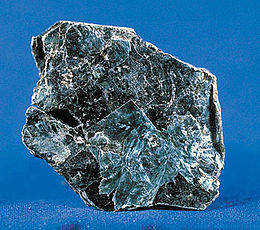
Back Vermikuliet AF فيرميكوليت Arabic Vermikulit AZ Вермікуліт BE Vermiculita Catalan Vermikulit Czech Vermiculit German Vermiculita Spanish Vermikuliit ET Vermiculita EU
| Vermiculite | |
|---|---|
 | |
| General | |
| Category | Phyllosilicates |
| Formula (repeating unit) | (Mg,Fe2+,Fe3+)3[(Al,Si)4O10](OH)2·4H2O |
| IMA symbol | Vrm[1] |
| Strunz classification | 9.EC.50 |
| Crystal system | Monoclinic |
| Crystal class | Prismatic (2/m) (same H-M symbol) |
| Space group | C2/m |
| Unit cell | a = 5.24 Å, b = 9.17 Å c = 28.6 Å; β = 94.6°; Z = 2 |
| Identification | |
| Color | Colorless, white, yellow, green, brown, black |
| Crystal habit | As large crystalline plates to clay-sized particles; lamellar to scaley |
| Cleavage | Perfect on {001} |
| Tenacity | Pliable |
| Mohs scale hardness | 1.5–2 |
| Luster | Greasy or vitreous (pearly at cleavage planes) |
| Streak | White or yellowish, translucent, shiny, light-brown or greenish in color, in some cases. For example, palabora vermuculite. |
| Diaphaneity | Translucent |
| Specific gravity | 2.4–2.7 (0.065–0.130 when exfoliated) |
| Optical properties | Biaxial (−) |
| Refractive index | nα = 1.525 – 1.561 nβ = 1.545 – 1.581 nγ = 1.545 – 1.581 |
| Birefringence | δ = 0.020 |
| Pleochroism | X in paler shades than Y and Z |
| References | [2][3][4] |
Vermiculite is a hydrous phyllosilicate mineral which undergoes significant expansion when heated. Exfoliation occurs when the mineral is heated sufficiently; commercial furnaces can routinely produce this effect. Vermiculite forms by the weathering or hydrothermal alteration of biotite or phlogopite.[3] Large commercial vermiculite mines exist in the United States, Russia, South Africa, China, and Brazil.
- ^ Warr, L.N. (2021). "IMA–CNMNC approved mineral symbols". Mineralogical Magazine. 85 (3): 291–320. Bibcode:2021MinM...85..291W. doi:10.1180/mgm.2021.43. S2CID 235729616.
- ^ Cite error: The named reference
Handbookwas invoked but never defined (see the help page). - ^ a b http://www.mindat.org/min-4170.html Mindat.org
- ^ Dave Barthelmy. "Vermiculite Mineral Data". webmineral.com.